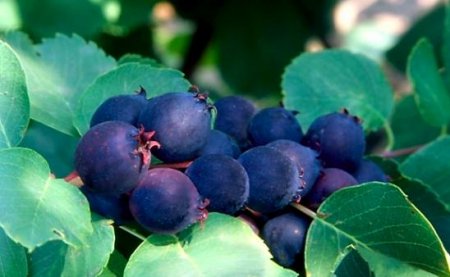
Saskatoon Berry History
Saskatoon berries (Amelanchier alnifolia) commonly known as Saskatoons, are purplish-blue berries that grow on bushes that can grow over 25 feet in height. Interestingly, other names used to describe this fruit are Service berries, June berries, and Shad berries. They are found all over the world. I even had an email with pictures of identical berries as mine from a lady in Sweden. Saskatoon berries look similar to blueberries with variation in color and size. The berries are purple-coloured, and the size varies due to different cultivars.
The Saskatoon berries people enjoy today are the same crop grown and enjoyed by the Aboriginal peoples of Western Canada hundreds of years ago. The name itself is derived from the Cree word “Mis-sask-quah-too-mina”, a word that sounds very similar to “Saskatoon”. The berries were a staple for both Aboriginal people and early settlers. The berries were enjoyed fresh, or steamed and mashed and then left to dry into a brick-like consistency for longevity. Pieces of these berry bricks were then chipped off as needed and added to soups, stews or simply boiled to reconstitute them.
The bush of the Saskatoon berries was useful to Aboriginal people as well. The leaves and fruit were dried and used to make tea. The wood of the bush itself was weighty and flexible and thus useful in arrows and other tools, basket frames and cross-pieces of canoes.
Several parts of the shrub were also used for medicinal purposes. Concoctions of the inner bark and roots were used to treat diarrhea, dysentery, painful menstruation, and bleeding during pregnancy. A warm decoction of the stems and twigs, or bark, was used by the women of the Thompson Indians to treat pain and bleeding after giving birth to a child. A root tea was believed to prevent miscarriage. The fruit was also used, along with spruce tips, blue currants and snowberry leaves and stems, as part of a concoction for gonorrhea. Some tribes boiled the inner bark of the Saskatoon to produce a remedy for snow-blindness; one drop of the strained fluid was placed in the affected eye three times daily. Fruit concoctions were also used for sore eyes and stomach problems.
This latter use, speaks to the nutritional value of the Saskatoon berry, which has been well researched and documented in our own time. The composition of Saskatoon berries is often compared to that of the blueberries, which has had strong market appeal and marketplace success. The Saskatoon berry however, has nutritional properties that are significantly higher in protein, fat, fiber, calcium, magnesium, manganese, barium, and aluminum than the blueberries. and are lower in phosphorus and sulfur. Saskatoon berries are also a source of Vitamin A and Vitamin C.
Saskatoon berries are a very versatile berry. They have long been treasured as a wild fruit and now with the growth in U-Pick Saskatoon orchards, the very best berries are available on the consumer market. Our cultured Saskatoons are generally the size of blueberries and can be used in many different recipes.